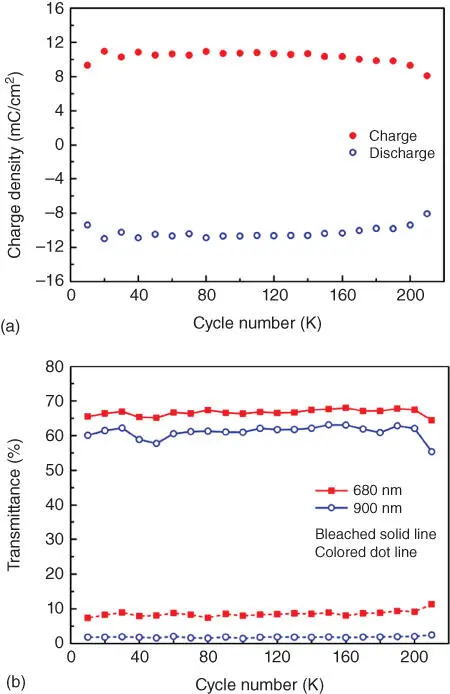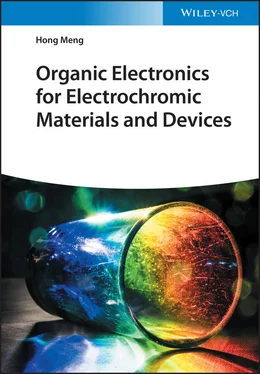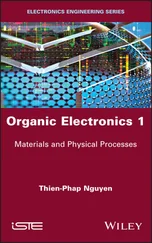1 ...7 8 9 11 12 13 ...20 
Figure 1.9 Open‐circuit memory tests of PBOTT‐BTD spray coated on an ITO‐coated glass slide in 0.1 M TBAPF6/ACN at 423 nm: (a) short‐ and (b) long‐term performance.
Source: Li et al. [21].
In most cases of laboratory study, researchers record the number of redox cycles that an EC material stand without significant loss in the performance as the electrochemical stability, irreversible oxidation or reduction at extreme potentials, side reactions with water or oxygen, and heat release in the system during switches may cause the degradation of electrochemical stability. Usually, the charge density Q drecorded under electrochemical cycling is up to 10 4–10 6, as shown in Figure 1.10a. The charge density of a Ti‐doped V 2O 5EC film haven't changed through 2 × 10 6cycles; meanwhile the transmittance change at a certain wavelength during continuous cycling is also important to describe the stability of an EC material. Such as shown in Figure 1.10b, the transmittance of the ECD remains stable through 200 000 cycles. Actually, the CE change after numerous cycles also can be used to evaluate the long‐term stability of EC materials, because it contains information of both transmittance and charge density.

Figure 1.10 Charge density (a) and transmittance (b) variation curves of ECD with the cycle number K : 1000.
Source: Wei et al. [30].
However, if we consider the real application of ECD in building windows, there are more strict conditions for durability and reliability. For instance, a lifetime over 20 years with more than 10 6switching cycles is necessary. Extreme weather conditions such as temperatures below −20 °C and above +40 °C are huge challenge for both EC materials and electrolytes, as well as other degradation factors such as high solar irradiation levels, fast temperature changes, uneven temperature distribution and additional stresses, rain, humidity, mechanical shock, and drying. Therefore, in 1998, Carl M. Lampert proposed a standard test guideline for industry application of EC [31], as shown in Figure 1.11. Recently, the International Organization for Standardization (ISO) also has launched an international standard: Glass in building – Electrochromic glazings – accelerated aging test and requirements (ISO 18543) for EC use in buildings.

Figure 1.11 Recommended testing guidelines for EC windows for exterior architectural applications.
Source: Lampert et al. [31].
In this chapter, a broad overview of electrochromism, EC materials, device structure, development history, and key parameters of electrochromism have been introduced briefly. More detailed descriptions of each area will be discussed in Chapters 2– 15. In summary, research in EC technologies has achieved significant breakthroughs over the decades. Many generations of EC materials have been developed, ranging from traditional metal oxides to more recent organic polymers, small molecules, and hybrid materials. Moreover, benefit from the ECD design and structural optimization, flexible substrate‐based devices were fabricated with the low‐price roll‐to‐roll process, which makes the EC technology have large scope applications, such as smart windows for reducing building energy consumption, self‐powered EC window using organic photovoltaic cells as power supplement, car rear‐view mirrors for greater safety, and smart sunglasses for better UV‐radiation protection. Many of these technologies and applications have been commercialized and are available on the market. With the concerted efforts of researchers and engineers, we believe that the new EC materials and advanced technologies will constantly develop and more advanced ECD with low manufacturing cost will be exploited to realize practical applications.
1 1 Fletcher, S. (2015). The definition of electrochromism. Journal of Solid State Electrochemistry 19 (11): 3305–3308.
2 2 Camurlu, P. (2014). Polypyrrole derivatives for electrochromic applications. RSC Advances 4 (99): 55832–55845.
3 3 Wang, Z., Wang, X., Cong, S. et al. (2020). Fusing electrochromic technology with other advanced technologies: a new roadmap for future development. Materials Science & Engineering R: Reports 140.
4 4 Wu, W., Wang, M., Ma, J. et al. (2018). Electrochromic metal oxides: recent progress and prospect. Advanced Electronic Materials 4 (8).
5 5 Mortimer, R.J. (2011). Electrochromic materials. Annual Review of Materials Research 41 (1): 241–268.
6 6 Platt, J.R. (1961). Electrochromism, a possible change of color producible in dyes by an electric field. The Journal of Chemical Physics 34 (3): 862–863.
7 7 Hutchison, M.R. (1913). Electrographic display apparatus and method. US Patent 1,068,774, filed 29 July 1913.
8 8 Lehovec K. (1957). Photon modulation in semiconductors. US Patent 2,776,367, filed 1 January 1957.
9 9 Neff, V.D. (1978). Electrochemical oxidation and reduction of thin‐films of prussian blue. Journal of the Electrochemical Society 125 (6): 886–887.
10 10 Michaelis, L. and Hill, E.S. (1933). The viologen indicators. The Journal of General Physiology 16 (6): 859–873.
11 11 Schoot, C.J., Ponjee, J.J., van Dam, H.T. et al. (1973). New electrochromic memory display. Applied Physics Letters 23 (2): 64–65.
12 12 Garnier, F., Tourillon, G., Garzard, M., and Dubois, J.C. (1983). Organic conducting polymers derived from substituted thiophenes as electrochromic material. Journal of Electroanalytical Chemistry 148: 299–303.
13 13 Mengoli, G., Musiani, M.M., Schreck, B., and Zecchin, S. (1988). Electrochemical synthesis and properties of polycarbazole films in protic acid media. Journal of Electroanalytical Chemistry and Interfacial Electrochemistry 246 (1): 73–86.
14 14 Zheng, H.B., Lu, W., and Wang, Z.Y. (2001). Electrochemical and electrochromic properties of poly(ether naphthalimide)s and related model compounds. Polymer 42 (8): 3745–3750.
15 15 Oishi, Y., Takado, H., Yoneyama, M. et al. (1990). Preparation and properties of new aromatic polyamides from 4,4′‐diaminotriphenylamine and aromatic dicarboxylic acids. Journal of Polymer Science Part A: Polymer Chemistry 28 (7): 1763–1769.
16 16 Cheng, S.‐H., Hsiao, S.‐H., Su, T.‐H., and Liou, G.‐S. (2005). Novel aromatic poly(amine‐imide)s bearing a pendent triphenylamine group: synthesis, thermal, photophysical, electrochemical, and electrochromic characteristics. Macromolecules 38 (2): 307–316.
17 17 Arimoto, F.S. and Haven, A.C. (1955). Derivatives of dicyclopentadienyliron. Journal of the American Chemical Society 77 (23): 6295–6297.
18 18 Whittell, G.R. and Manners, I. (2007). Metallopolymers: new multifunctional materials. Advanced Materials 19 (21): 3439–3468.
19 19 Wade, C.R., Li, M., and Dincă, M. (2013). Facile deposition of multicolored electrochromic metal–organic framework thin films. Angewandte Chemie International Edition 52 (50): 13377–13381.
20 20 Hao, Q., Li, Z.‐J., Lu, C. et al. (2019). Oriented two‐dimensional covalent organic framework films for near‐infrared electrochromic application. Journal of the American Chemical Society 141 (50): 19831–19838.
Читать дальше















